Duende


“All through Andalusia, from the rock of Jaén to the snail’s-shell of Cadiz, people constantly talk about the duende and recognize it wherever it appears with a fine instinct. That wonderful singer El Lebrijano, creator of the Debla, said: ‘On days when I sing with duende no one can touch me.’: the old Gypsy dancer La Malena once heard Brailowsky play a fragment of Bach, and exclaimed: ‘Olé! That has duende!’ but was bored by Gluck, Brahms and Milhaud. And Manuel Torre, a man who had more culture in his veins than anyone I’ve known, on hearing Falla play his own Nocturno del Generalife spoke this splendid sentence: ‘All that has dark sounds has duende.’ And there’s no deeper truth than that.”
—Federico García Lorca, writer of Theory and Play of the Duende [1]
|
According to dictionary.com, “In lists compiled by linguists and translators, it seems “duende” is a word that many experts regard as the hardest word in Spanish to convey in other languages.” [2] The band They Might Be Giants wrote an entire song trying to define duende in which it was described as being “Necropolis Blownapart”, “Apocryphal Espadrille”, and “Dystopio Smashedtobits.” [3] Wikipedia calls says it, “loosely means having soul, a heightened state of emotion, expression and authenticity, often connected with flamenco.” [4] Federico García Lorca, in Theory and Play of the Duende describes the duende with definitions and characteristics including “A mysterious force that everyone feels and no philosopher has explained”, “The arrival of the duende presupposes a radical change to all the old kinds of form, brings totally unknown and fresh sensations, with the qualities of a newly created rose, miraculous, generating an almost religious enthusiasm”, "The duende, by contrast [with muses and angels as metaphorical inspiration for art], won’t appear if he can’t see the possibility of death, if he doesn’t know he can haunt death’s house, if he’s not certain to shake those branches we all carry, that do not bring, can never bring, consolation. With idea, sound, gesture, the duende delights in struggling freely with the creator on the edge of the pit. Angel and Muse flee, with violin and compasses, and the duende wounds, and in trying to heal that wound that never heals, lies the strangeness, the inventiveness of a man’s work. The magic power of a poem consists in it always being filled with duende, in its baptizing all who gaze at it with dark water, since with duende it is easier to love, to understand, and be certain of being loved, and being understood, and this struggle for expression and the communication of that expression in poetry sometimes acquires a fatal character”, and “The duende… Where is the duende? Through the empty archway a wind of the spirit enters, blowing insistently over the heads of the dead, in search of new landscapes and unknown accents: a wind with the odor of a child’s saliva, crushed grass, and Medusa's veil, announcing the endless baptism of freshly created things.”
So with a proper introduction to the feelings and ideas surrounding what the duende is, how do we recognize it as a trope?
Christopher Maurer, editor of In Search of Duende noticed four traits come together to present Lorca's understanding of the duende: irrationality, earthiness, a heightened awareness of death, and a dash of the diabolical. [5] Still, this definition does not account for the "dark sounds" that are heavily linked with the duende, so it would be valuable to append to Maurer's list "dark undertones that present a sense of authenticity." It should also be taken into consideration that duende causes an intense or somewhat melancholy desire to create new things.
Gallery
-
Vincent Van Gogh - Wheatfield with Crows
-
Francisco de Goya y Lucientes - Witches' Sabbath (The Great He-Goat)
-
Vincent van Gogh - The Church in Auvers-sur-Oise, View from the Chevet
-
Turner - Snow Storm, Steam-Boat off a Harbour's Mouth
Art
- Various examples of paintings considered to have duende are shown in the gallery above. Duende in paintings and other flat mediums is considered to be rare as it often requires an element of the spontaneous.
- Duende in sculpture is considered to be quite rare, even more so than paintings or other flat mediums [6], but the Moai of Easter Island (🗿) are considered an example.
Dance
- Flamenco is considered to be especially related to duende. Other dancing as well, but not to as great an extent.
Music
- Flamenco singer Pastora Pavon is said by Lorca to have sung with duende, but only after tearing her voice apart. [7]
Philosophy
- Lorca describes several philosophers as having or being related to the duende: http://www.poetryintranslation.com/PITBR/Spanish/LorcaDuende.php
- Socrates, notably when he drank the hemlock
- Nietzsche and Cézanne, in that every step toward perfection is the result of their struggle with their duende
This page needs more examples. You can help this wiki by adding more entries or expanding current ones. |
- ↑ http://www.poetryintranslation.com/PITBR/Spanish/LorcaDuende.php
- ↑ http://www.dictionary.com/e/duende/
- ↑ http://tmbw.net/wiki/Lyrics:Three_Might_Be_Duende
- ↑ https://en.wikipedia.org/wiki/Duende_(art)
- ↑ Maurer (1998) pp. ix-xx
- ↑ https://web.archive.org/web/20180226110907/http://www.duendeart.org/
- ↑ http://www.poetryintranslation.com/PITBR/Spanish/LorcaDuende.php


